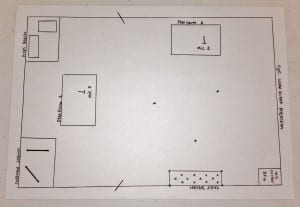After advertising the event throughout the University via siren fm, with posters and emails it was finally time for our fundraising event which revealed more about our show and company. We also advertised heavily through social media by giving sneak previews of our musical content to entice people. We bought buckets and added our logo, as well as ordering leaflets for the event. Those who attended and donated also received a sticker of our logo to show their support and bring in potential interest. 
(Above: Acoustic Night Set-Up, taken by Kirsty Jakins)
After the whole company set up the event like you can see above, our audience began to arrive. We introduced the event to reveal more about  our show, and ensured all knew the box office was open until 6 so if they liked what they saw, tickets could be purchased! Then it was time for the event to begin. Those who were not performing advertised our stickers and let people know what the event was all about. The rest of us performed a range of music, from acoustic covers of ‘Living on a Prayer’ to reinterpreted versions of ‘A Change is Going to Come’. With a break in between the set, we gave people time to relax and enjoy the evening, as well as giving a chance to purchase tickets or donate. We filmed some live footage of the event and raised a fair sum of money afterwards. We also reicived great feedback on twitter and it seems people are extremely excited about our show! All in all the event was definitely a success and showed more about who we are as a company and what we are planning to do.
our show, and ensured all knew the box office was open until 6 so if they liked what they saw, tickets could be purchased! Then it was time for the event to begin. Those who were not performing advertised our stickers and let people know what the event was all about. The rest of us performed a range of music, from acoustic covers of ‘Living on a Prayer’ to reinterpreted versions of ‘A Change is Going to Come’. With a break in between the set, we gave people time to relax and enjoy the evening, as well as giving a chance to purchase tickets or donate. We filmed some live footage of the event and raised a fair sum of money afterwards. We also reicived great feedback on twitter and it seems people are extremely excited about our show! All in all the event was definitely a success and showed more about who we are as a company and what we are planning to do.


